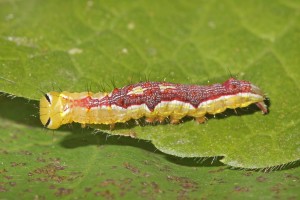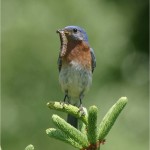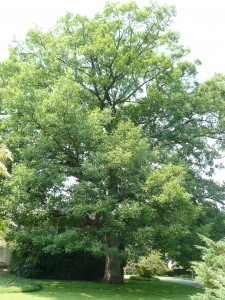By Edie Parnum
dd
Planting an oak is the single most important thing we can do to support wildlife.
As a birder who loves spring migration, I have long noticed that my beloved warblers and other colorful birds prefer the native oak trees. On May mornings, just when their foliage is emerging, I scan the oaks. That’s where I find American Redstarts, Blackburnian Warblers, Scarlet Tanagers and other favorites in their resplendent spring plumage. Only recently have I learned why these birds are in the oaks. I credit Doug Tallamy, Professor of Entomology at the University of Delaware and author of Bringing Nature Home. Oaks, according to Tallamy, support 534 species of lepidoptera (butterfly and moth) caterpillars– more than any other native tree or plant. These caterpillars are not only the primary food source for migrating and breeding birds, but are essential food for baby birds. Other native plants support caterpillars, too, but non-native plants host very few at all.
I’ve always known that acorns are important food for turkeys, woodpeckers, jays, nuthatches, squirrels, chipmunks and other animals. However, birds and other animals are even more dependent on the insects that munch on the oak leaves. According to Tallamy, in addition to myriad lepidoptera species, oaks host aphids, leafhoppers, thrips, and other bugs–all target foods for animals throughout each growing season.
Professional landscapers may try to dissuade you from planting an oak. They’ll tell you it grows too big for the average-sized yard, though most yards are big enough to support a full-sized mature oak.
Perhaps, without any sense of irony, they will say that an oak will grow too slowly. Certainly most oaks will be small for many years, but even young trees will support lots of insects.
While there are many local, native oaks to choose from, the handsome White Oak (Quercus alba) is my personal favorite. From my childhood days in Salem County, NJ, I have fond memories of a nearby magnificent, ancient White Oak. John Fenwick, an early settler, signed a treaty with the Lenape Indians in 1676 under this tree, now approximately 425 years old. This species grows slowly (about a foot per year), but can live for centuries.
Other recommended oak species include Scarlet Oak (Q. coccinea), Chestnut Oak (Q. montana), RedOak (Q. rubra), and Black Oak (Q. velutina). These oaks are available at native plant nurseries and native plants sales. Since oaks have long tap roots, choose a small specimen (4’ or less) or grow your own from an acorn. Because they are adapted to our soils and climate, no fertilizer or other amendments are needed. However, regular watering during the first year helps the root system get established.
An oak is your personal legacy. Your oak can live for centuries. It will host an inestimable number of birds, insects, and other wildlife during your own lifetime and for generations to come.




The blog looks great! Oh, and I learned something from the post. GREAT JOB!
Thanks for starting this blog for SE PA. I look forward to reading each article and post. Nice job on the website too – clean look and aesthetically pleasing. Well done.
Welcome to the blogosphere. It is nice to have your voices and perspective added to the growing community of conservation oriented gardeners.
Here is another nice blog (there are a few others of course)
http://nativeplantwildlifegarden.com/
Great debut article, Edie! It’s so nice to see you here on the web, and writing about how we can all create welcoming habitat for wildlife in our own gardens. You’re so right about Oaks! They are so important to birds and other wildlife. According to Tallamy’s research, oaks support over 500 different kinds of butterflies and moths, which means that hungry warblers are sure to find a tasty snack. Thanks also for linking to my team at Native Plants and Wildlife Gardens.
Well, I had no idea that oaks were so significant in a back yard. I have embarked on a multi-year program of eradicating the huge Norway maples that I inherited on my property, and of course I’m replacing them with natives. I will be sure to plant some oaks when the next maple is removed. We love seeing the warblers in the vegetable garden, but we don’t see them so much in the woods. Maybe that’s because we don’t have many oak trees yet. I would be pleased to be feeding more birds and fewer deer.
Great work on the beautiful website, and love the truth of the oak article. I was talking with Catherine Smith at Redbud Native Plant Nursery [http://www.redbudnativeplantnursery.com/] this spring about small oaks. She showed me 2 smaller forms at her nursery, if you are struggling with the “mature size” issue in a modest yard: Bear Oak (Quercus ilicifolia) and Blackjack Oak (Quercus marilandica). Both like drier soils, but should be tough. Bear Oak is truly shruby, and Blackjack is a small tree. At any rate, I agree with Edie–sit back and watch your oak grow. Those in my yard have more beneficial years left than I do.
I never realized how important oak trees were